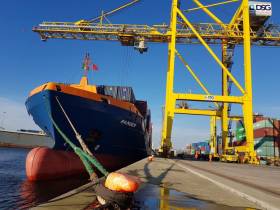Displaying items by tag: MacAndrews
Oldest Shipping Company In the World Bids Farewell But 'Containerships' Continue Irish Services
#ports&shipping - In what was considered to be the oldest existing shipping company and originally Scottish based has merged this month with a French owned container giant's Finnish subsidiary, writes Jehan Ashmore
MacAndrews which was established in 1770 dissapeared from the shipping scene on 1 April marking a long association as part of the UK shipping industry. The demise of MacAndrews GmBH followed the merger by French owners CMA CGM into a single brand through their subsidiary Containerships.
In 2002 MacAndrews had been aquired by the German concern that led to headquarters relocating to Hamburg, but retained its original name. The company the following year was acquired by CMA CGM from Andrew Weir Shipping whose ship managment arm as previously reported on Afloat included former RMS St. Helena which notably made a once-off charter cruise to Irish ports
The historic company of MacAndrews Line can trace its origins to its founder William McAndrew from Elgin, Scotland. At just 18 year's old, he traded in importing fruit from Spain, Portugal and the Azores. This led offices to be opened in London and Liverpool.
MacAndrews operations included calls to Ireland that continue through Containerships in the provision of Intra-European transport. Of the Irish ports Containerships call to Dublin, Cork and Belfast.
Among the network of routes from Ireland is the Portugal Service linking the Iberian nation with the UK, Ireland, France, Spain and the Netherlands. This is a two-loop weekly door-to-door multimodal service linking the ports of Liverpool, Dublin, Setúbal, Leixoes, Dunkirk, Rotterdam and Tilbury.
A trio of containerships, each with a 803TEU nominal capacity operate the service among them MV Ranger (pictured above) in Dublin Port at DSG's lo-lo terminal. Also note yesterday's related stories.
The integration of MacAndrews into Containerships will allow for the creation of a tailored intra-regional service, in what CMA CGM Group desrcibe as a “Customer Centricity” strategy. To service Containerships 26 maritime services and 8 inland services there is a fleet of 32 vessels and 700 trucks.





























































